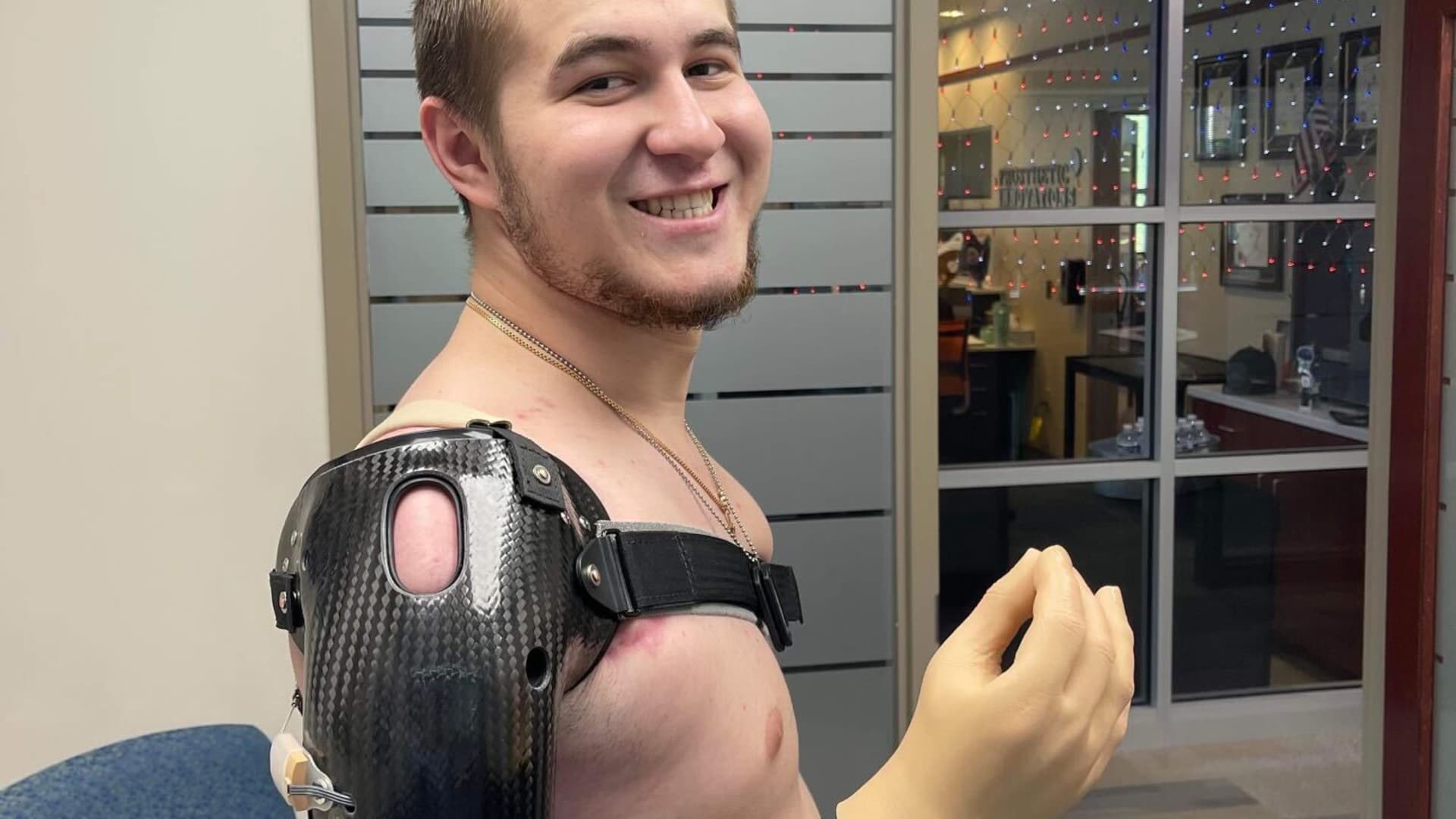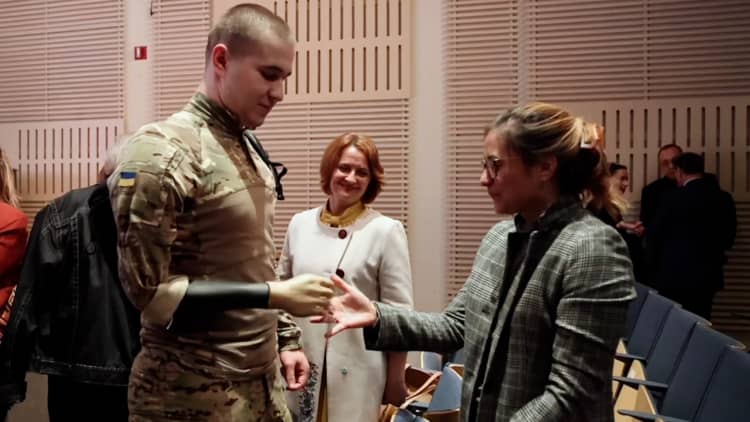Wounded soldier reflects on his recovery


NEW YORK — “He wants to know if he can shake your hand,” Roman Horodenskyi’s translator said as he stood beside the 20-year-old Ukrainian soldier.
“He’s only had his arm for two weeks, so he’s still getting used to operating it,” his translator added during an interview with CNBC in November. He then told Horodenskyi in their native Ukrainian that he could practice the greeting.
The 6-foot-3-inch Ukrainian marine smiled and extended his right arm, a lightweight fusion of silicon, carbon fiber composites and thermoplastic. Taking several deep breaths, the 230-pound gentle soldier gazed down at the dynamic limb, widened his fingers and slowly tightened his grip around a reporter’s hand.
A breath of relief and another smile moved across his face.
“He lost his hand and leg in a mine explosion,” said Horodenskyi’s translator, Roman Vengrenyuk, a volunteer for Revived Soldiers Ukraine, a nonprofit dedicated to bringing wounded troops to the U.S. for specialized health-care treatment.
Horodenskyi, a double amputee as a result of Russia’s war, is one of 65 wounded Ukrainian service members to benefit from the nonprofit’s work, which provides treatment in Chicago, Philadelphia, New York, Boston and Orlando. Vengrenyuk accompanied Horodenskyi to New York for events over the past several months raising awareness of what has now become a tragic, yearlong Russian onslaught across Ukraine.
“Our nonprofit found him, and he’s only 20 years old. He has so much more life ahead of him,” Vengrenyuk told CNBC, adding that the two fell into a quick, deep friendship.
In a separate conversation with CNBC, Revived Soldiers Ukraine President Iryna Discipio said the effort to aid wounded soldiers “is extremely important.”
“Ukraine is focusing on fighting a war, and we are helping heroes who are left behind. We are helping the Ukrainian army by taking care of wounded servicemen,” Discipio said.
“Also, it’s important to show here in the United States the outcome of this war,” she added.
Horodenskyi, affectionately referred to as the “miracle from Mariupol,” was one of the Ukrainian defenders who survived the Russian carnage in the strategic port city last spring.
Mariupol’s first line of defense
A man holds a child as he flees a Ukrainian city, on March 7, 2022.
Aris Messinis | AFP | Getty Images
In the predawn hours of Feb. 24, Russian troops poured over Ukraine’s borders while missiles flashed across the dark sky, marking the inception of the largest air, sea and ground assault in Europe since World War II.
For months leading up to the full-scale invasion, the U.S. and its Western allies watched a steady buildup of Kremlin forces along Ukraine’s border with Russia and Belarus. The increased military presence mimicked Russian moves ahead of its 2014 illegal annexation of Crimea, a peninsula on the Black Sea, which sparked international uproar and triggered sanctions aimed at Moscow’s war machine.
The Kremlin all the while denied that its colossal troop deployment along Ukraine’s borders was a prelude to an assault.
Since Russia invaded its fellow ex-Soviet neighbor a year ago, the war has claimed the lives of more than 8,000 civilians, led to nearly 13,300 injuries and displaced more than 8 million people, according to U.N. estimates.
Meanwhile, the lives of many soldiers such as Horodenskyi who had survived their ordeals were forever changed by the brutal conflict.
At the time of the invasion, Horodenskyi was serving with the 36th Brigade of the Ukrainian marines as a machine gunner near Mariupol. Following in the footsteps of the men in his family, Horodenskyi had joined the military when he was 18 years old. He exchanged his hometown of Odesa, a populous municipality on the Black Sea coast, for the once-industrious southeastern port city of Mariupol on the Sea of Azov.
In April, the marines in Horodenskyi’s unit were the first line of defense in the city, which was home to 400,000 people before the war.
His unit was scattered around the perimeter of Illich Iron and Steel Works, Europe’s largest manufacturer of galvanized steel, when Russian fire encroached on his position. Horodenskyi moved behind a tree.
While he can recall the mine explosion that took his left leg and shredded his right arm, the aftermath is a blur.
He remembers his fellow marines moving him, he remembers the pressure of the tourniquets and the rush to a makeshift field hospital.
“I was in this sort of dark basement shelter with other wounded soldiers. There was hardly any medicine or supplies or food. There was really nothing,” Horodenskyi recalls.
For a little over a week, he sheltered in place with his “brothers,” as he calls them, until the last of the painkillers, bandages, water and ammunition ran out. Meanwhile, Russia bombarded the expended Ukrainian marines, and troops continued to advance on them.
“His commander made the difficult decision to surrender to the Russians, and the wounded were taken to a field hospital in Donetsk,” Vengrenyuk said. “At that facility, there was one side for the [uninjured] imprisoned, another for wounded Ukrainian soldiers and a separate area for injured Russian soldiers.”
Horodenskyi detailed a horrifying account of his nearly three weeks in the Russian military hospital. Russian troops staying in the hospital who could move on their own were allowed access to the open room where wounded Ukrainian soldiers were kept. They openly beat, harassed and tortured Horodenskyi and his comrades, he said.
He recalled a group of Russian troops along his bedside poking the exposed bone protruding from his right shoulder. Soldiers took turns interrogating him while grabbing the bone and twisting it, he said.
He remembers the excruciating pain.
While he was in the hospital, Horodenskyi’s condition rapidly declined, and Russian surgeons amputated what remained of his right arm. By May, he had become septic, a condition that threatens organ failure, tissue damage and death if not quickly treated.
Plagued with sepsis and with a life expectancy of no more than a week, Horodenskyi was returned to the Ukrainian military in a prisoner swap.
“The Russian commander obviously didn’t want Roman to die in their hospital because then he couldn’t be used as a bargaining chip to release one of their own,” Vengrenyuk said. “But he’s young and his body was strong enough to survive.”
‘To think of everything he has been through’
Roman Horodensky, 20, poses with a prosthetic arm at a clinic in the United States after losing the limb during combat in Mariupol, Ukraine while fighting for the Ukrainian Armed Forces.
Photo: Roman Vengrenyuk
Horodenskyi underwent nearly a dozen surgeries in his hometown of Odesa before he traveled to the United States, where he was outfitted with prosthetics.
He received a prosthetic leg in Orlando in September, and then his arm in Eddystone, Pennsylvania, about 30 minutes outside Philadelphia.
“To think of everything he has been through,” certified prosthetist Michael Rayer, of Prosthetic Innovations in Eddystone, told CNBC when asked to reflect on Horodenskyi’s journey.
“Just the nicest guy,” he added.
Rayer recalled that in his first encounter with Horodenskyi, he saw that the Russian amputation had left only about an inch and a half of the humerus bone in his right arm. It made the process of fitting a prosthetic more difficult.
“He really did not have a lot of real estate to work with,” Rayer said. “There’s a lot of weight that gets transferred to that small residual limb and so, we spent a lot of time refining the prosthesis to make sure he was comfortable.”
“Our office has a lot of experience in poly traumas, which are people that have lost multiple limbs, which adds a whole different layer of care,” he said. “Because, how do you put on one of your lower extremities if you only have one arm or if you have no arms?”
Roman Horodensky, 20, poses with a prosthetic arm at a clinic in the United States after losing the limb during combat in Mariupol, Ukraine while fighting for the Ukrainian Armed Forces.
Photo: Roman Vengrenyuk
Rayer, who spent eight weeks in total with Horodenskyi, said the arm prosthesis he received can cost as much as $70,000.
“We donated all of our time, and we were able to do it for about half of that,” Rayer said.
Rayer added that it can take anywhere from several months to years to develop full mastery of the prosthesis. He said that while every person takes a different length of time to adjust, he noticed that in his work with Ukrainian soldiers, he found that they “are very mechanically adept.”
“They really understand the way that something works, and they understand how to make it work for them. I don’t know if that’s their military training, but they all seem to really adjust fairly quickly,” he added.
After he received care in the U.S., Horodenskyi returned to Ukraine and proposed to his girlfriend, Viktoriia Olianiyk, whom he dated before the war broke out. The couple married in December in Ukraine.
Horodenskyi’s injuries have not dampened his desire to rejoin the military, as Ukrainian troops hold out for longer than just about anyone outside the country expected them to against Moscow’s might.
“I really want to go back to fight,” he told CNBC in his native Ukrainian, pausing for Vengrenyuk to translate.
“My entire country is fighting fiercely, and many of my brothers are still imprisoned,” he said.





